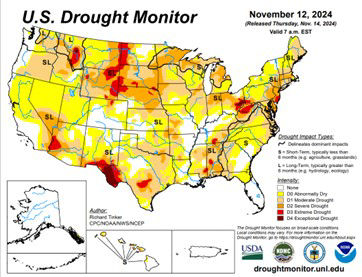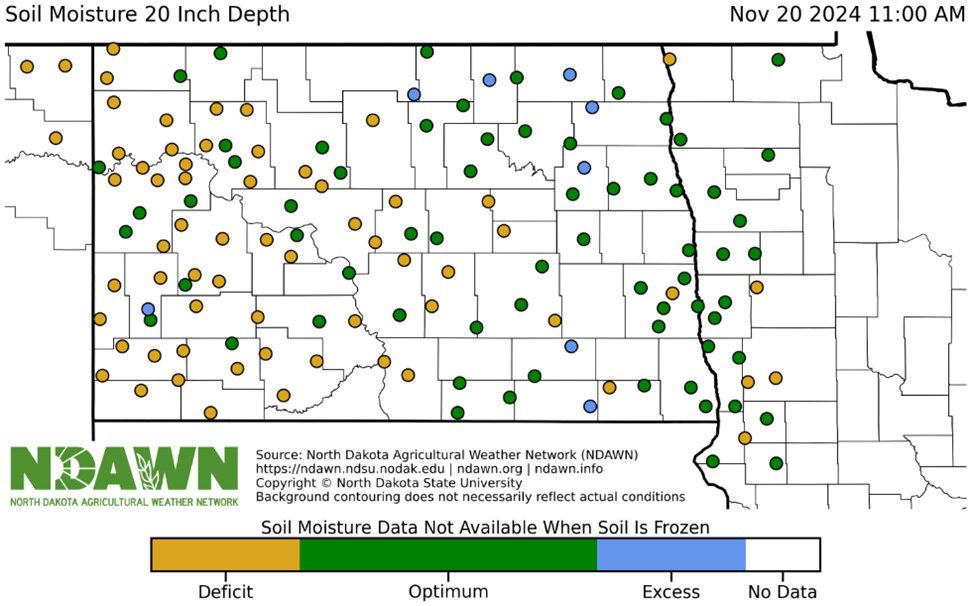Should Planting Depth and Planting Rates be changed for Corn and Soybean following a Drought?
January 3, 2025
2024 was a year that gave us challenges from beginning to end. Included in those challenges were a combination of drought conditions in many areas (Figure 1).1 As we begin our planning for 2025, the question of potentially changing tactics is on the minds of many.

Figure 1. U.S. Drought Monitor map. The U.S. Drought Monitor is jointly produced by the National Drought Mitigation Center at the University of Nebraska-Lincoln, the United States Department of Agriculture, and the National Oceanic and Atmospheric Administration. Map courtesy of NDMC.1
Planting Depth
A corn seed needs to imbibe around 30% of its weight in moisture from the soil at planting.2 It is of utmost importance that planting depth is at a level where soil moisture is present. Ideal planting depth for corn is 1.75 to 2.5 inches. Most importantly, in dry soil conditions, fields should not be overworked to help maintain topsoil moisture. Additionally, timely planting is key to help provide the best chances for germination before the topsoil profile dries out.
A soybean seed needs to absorb about 50% of its weight in water to begin germination.3 Therefore, placing the seed into the water holding interface in the field is more important than in corn. Maintaining a firm seedbed and firming the seed trench with the planter can help to keep the moisture close to the seed and help prevent moisture loss due to evaporation.
Seeding Rate
The subject of seeding rate should include a consideration of how drought impacted soil fertility in 2024. Normally, a drought results in a smaller crop than normal and in turn, leaves a higher level of background nutrients.4 So, if your soil tests show a little extra fertility available, seeding rates should take full advantage of that potential.
Secondly, the old saying that “rain makes grain” is truly paramount. The State Climatologist where I live has a very simple message, that “if it rains at the right time of the year, you will have a great crop.” Truer words have never been spoken. Thus, I like to think about seeding rates in this way: plan for normal, in whatever way that normal is for your farm. In other words, we really have no way to predict the rainfall for the season, so plan on a normal year in the ways that have provided success in the past.
Finally, many states utilize soil monitoring stations that can give you a relative idea of soil moisture right up to planting. This tool can be used to make last minute adjustments before planting. As I finish this article, my area has been receiving widespread moisture so let’s hope we get a great recharge prior to freeze up for the year.

Channel Agronomist
Derek Crompton
Sources
1Tinker, R. U.S. Drought Monitor. National Drought Mitigation Center, University of Nebraska-Lincoln. The U.S. Drought Monitor is jointly produced by the National Drought Mitigation Center at the University of Nebraska-Lincoln, the United States Department of Agriculture, and the National Oceanic and Atmospheric Administration. Map courtesy of NDMC. https://droughtmonitor.unl.edu/CurrentMap.aspx
2Dodd, J. 2020. Seed dormancy to activity. Corn Journal. https://www.cornjournal.com/corn-journal/archives/03-2020
3McDonald, M.B.J., Vertucci, C.W., and Roos, E.E. 1988. Soybean seed imbibition: water absorption by seed parts. Crop Science 28(6): 993-997. EurekaMag. https://eurekamag.com/research/001/950/001950309.php
4Barker, B. 2022. Fertilizing after a drought. What are the considerations and options? Agronomy Fertility and Nutrients. Top Crop Manager. https://www.topcropmanager.com/fertilizing-after-a-drought/
5North Dakota Agricultural Weather Network (NDAWN). North Dakota State University. https://ndawn.info/soil.html
Web sites verified 11/22/24 1110_487802